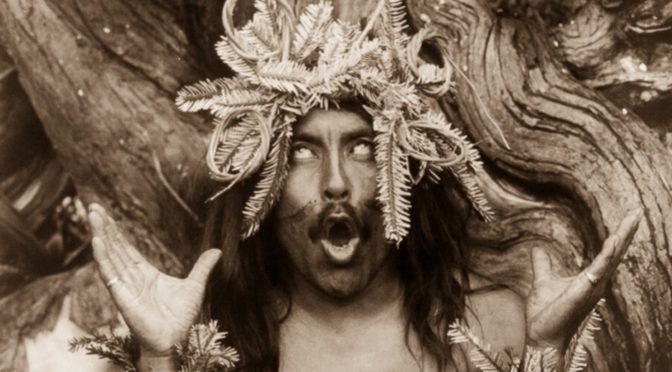
Sioux Chiefs, 1905
Edward Sheriff Curtis was born on a Wisconsin farm in 1868, and ended up a commercial photographer in Seattle. He is famous for photographing Princess Angeline, the daughter of the Duwamish chief Seattle, for whom the city was named.
That experience kindled a fascination with Native American culture within him that would remain for the rest of his life. He photographed tribal people during expeditions to Alaska and Montana, and was also approached by J.P. Morgan about funding a documentary project of American indigenous people. The result was a 20-volume series called The North American Indian.
Backed by Morgan, Curtis spent over 20 years traveling North America, capturing more than 40,000 pictures of over 80 different tribes. In addition, he made thousands of recordings of native songs and language, and wrote down their histories, legends, and biographies of their great people.
In an effort to capture what he saw as a swiftly disappearing tribal culture, Curtis at times posed his subjects in settings that more resembled their pre-Western settlement existences rather than their actual present lives. All stereotypes aside, Curtis’ exhaustive body of work is an impressive historical record of Native life at the beginning of the 20th century.

Navajo traveling through Canyon de Chelly, AZ, 1904

Apsaroke mother and child, 1908

Luzi of the Papago tribe, 1907

A Qagyuhi woman wears a fringed Chilkat blanket and a mask representing a deceased relative who had been a shaman, 1914

Hakalahl, a Nakoaktok chief, 1914

A Kwakluti gatherer hunts abalones in Washington, 1910

Piegan girls gathering goldenrod, 1910

A Qahatika girl, 1907

A young Apache, 1910

Eskadi of the Apache, 1903

Kwakiuti people in canoes in British Columbia, 1914

Kwakiuti people in canoes in British Columbia, 1914

A Kwakiuti wedding party arrives in canoes, 1914

A Kwakiuti shaman performs a religious ritual, 1914

A Koskimo man dressed as Haml (“dangerous thing”) during a Numhim ceremony, 1914

A Qagyuhi dancer dressed as Paqusilahl (“man of the ground embodiment”) 1914

A Qagyuhi man dressed as a bear, 1914

Qagyuhi dancers, 1914

Nakoaktok dancers wear Hamatsa masks in a ritual, 1914

Apache man, 1910

Hollow Horn Bear, a Brulé man, 1907

A Tewa girl, 1906

An Apache woman reaps grain, 1910

A Mariposa man on the Tule River Reservation, 1924

A Hidatsa man with a captured eagle, 1908

A Nootka man aims a bow and arrow, 1910

Piegan tepees, 1910

Sioux hunter, 1905

A Kwakiutl shaman, 1914

A Kwakiutl man wearing a mask depicting a man transforming into a loon, 1914

An Apsaroke man on horseback, 1908

A Klamath chief stands on a hill above Crater Lake, Oregon, 1923

Iron Breast, a Piegan man, 1900

Black Eagle, an Assiniboin man, 1908

Nayenezgani, a Navajo man, 1904

A Kwakiutl person dressed as a forest spirit, Nuhlimkilaka, (“bringer of confusion”), 1914

A Hupa woman, 1923

Mowakiu, a Tsawatenok man, 1914

Piegan chiefs, 1900

Vash Gon, a Jicarrilla man, 1910

“The Hopi Maiden,” 1905

A Jicarrilla girl, 1910

A Zuni woman, 1903

Iahla, also known as “Willow,” of the Taos Pueblo, 1905

A Papago woman, 1907

A Hupa spear fisherman watches for salmon, 1923

A Maricopa woman, 1907

Okuwa-Tsire, also known as “Cloud Bird,” of the San Ildefonso Pueblo, 1905

A Maricopa woman with arrow-brush stalks, 1907

An Apsaroke shaman, 1908

A Kwakiutl chief’s daughter, 1910

A Kutenai duck hunter, 1910

Members of the Qagyuhl tribe dance to restore an eclipsed moon, 1910
All images courtesy of Edward S. Curtis/Library Of Congress

